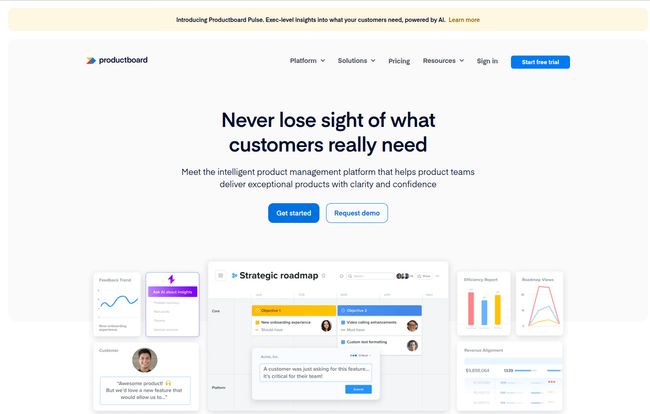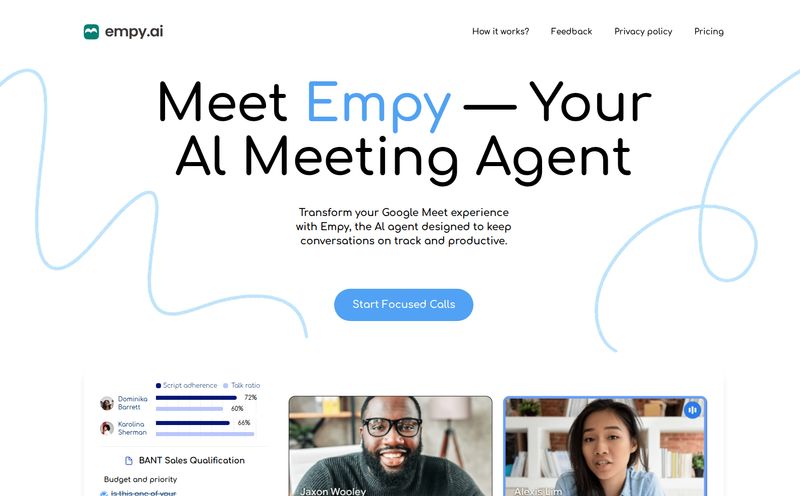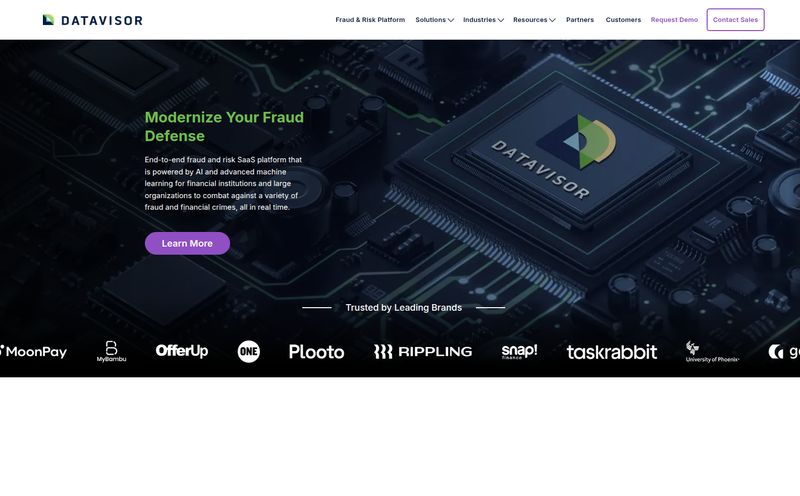Being a product manager can feel like you’re a professional plate-spinner in the middle of a hurricane. You’ve got customer feedback flooding in from Slack, Zendesk, and that one super-passionate user who emails you directly. You’ve got the sales team promising the moon to close a deal. Engineering is asking for clear specs, and leadership wants a slick, confident roadmap for the next board meeting. It's... a lot.
For years, we've cobbled together solutions. Trello boards that become graveyards of forgotten ideas, sprawling spreadsheets that only one person understands, and endless PowerPoint decks that are outdated the second you hit 'save'. I've been there, and frankly, I'm tired of it. So when a tool comes along promising to be the central nervous system for your entire product development lifecycle, my curiosity gets piqued. That tool is Productboard.
But is it just another shiny object, or is it the real deal? I’ve spent some quality time with it, and I’ve got some thoughts.

Visit Productboard
So, What is Productboard, Really?
On the surface, it's a product management software. But that's like calling a smartphone a pocket calculator. Productboard’s mission is to give product teams a single, shared space to understand what customers need, figure out what to build next, and get everyone on the same page with a clear roadmap. Think of it less as a tool and more as a philosophy made manifest in software. Its whole reason for being is to stop you from “losing sight of what customers really need.”
It’s built to be the one place you go to answer the three big questions that keep PMs up at night:
- What do our users actually want?
- Out of everything we could build, what should we build next?
- How do we communicate this plan to everyone without causing mass confusion?
It aims to be the Rosetta Stone that translates messy, chaotic feedback into clear, actionable strategy. A tall order, but one they seem to take seriously.
The Pain Points Productboard Aims to Heal
Before we get into the nuts and bolts of the features, lets talk about the 'why'. Why would you even need something like this? If you're a product person, some of this might sound painfully familiar.
There's the classic 'Feedback Anarchy'. A customer mentions a brilliant idea to a support agent. A big-shot client tells their account manager about a 'must-have' feature. A developer has a stroke of genius during a stand-up. Where does all this gold go? Usually, into the ether. Or worse, a dozen different places. Productboard is designed to be the Fort Knox for this feedback.
Then there's the 'Loudest Voice' problem. Prioritization often becomes a battle of wills. The stakeholder with the most convincing argument or the highest-ranking title wins, not necessarily the best idea. This platform tries to replace gut feelings and office politics with a more objective, data-driven approach. It gives you the ammo to say, “I understand your request, but here’s data from 50 other customers asking for this other thing that aligns with our Q3 objectives.” That's a conversation-changer.
A Look at Productboard's Core Features
Alright, let's pop the hood and see what makes this thing run. Productboard is built on a few key pillars that work together to create a cohesive system.
Your Single Source of Truth for Customer Insights
This, for me, is the heart of the whole platform. Productboard gives you a centralized insights repository. You can pipe in feedback from just about anywhere—Intercom, Zendesk, Slack, email, surveys, you name it. No more copying and pasting notes into a spreadsheet at 2 AM.
But here’s the magic part: it uses AI-powered feedback analysis. Instead of you manually reading and tagging every single piece of feedback (a soul-crushing task, believe me), Productboard can automatically surface trends and identify recurring themes. It can see that 27 people have mentioned “dark mode” or that enterprise users are struggling with a specific integration. This is a massive time-saver and helps you spot opportunities you might otherwise miss.
Prioritization That Isn't Just a Guessing Game
Once you have all that rich customer feedback, what do you do with it? This is where Productboard’s prioritization features come in. You can link feature ideas directly to the user feedback that supports them. Suddenly, that “nice-to-have” feature is backed by requests from customers representing $50k in ARR. That changes things.
You can create prioritization scores based on criteria you define—like strategic value, user impact, or development effort. It helps you move from a subjective “I think we should do this” to an objective “This feature has the highest potential impact for our target segment.” It’s about making smarter, more defensible decisions.
Roadmaps That People Will Actually Look At
If you’ve ever presented a roadmap in a meeting only to have it questioned from every angle, you’ll appreciate this. Productboard allows you to create dynamic, tailored roadmaps for different audiences.
Your executive team gets a high-level, theme-based view focused on strategic goals. Your engineering team gets a more granular, release-focused view with clear objectives. The sales team can see a version that highlights the upcoming features they can talk about with prospects. These aren't separate documents you have to maintain; they’re just different views of the same underlying plan. When the plan changes (and it always does), all the roadmaps update automatically. It’s glorious.
Who Is This For? (And A Little Tough Love)
Productboard is a fantastic fit for product-led organizations of almost any size, from growing startups to established enterprises. Product managers, product leaders, and even adjacent teams like marketing and customer success will find a lot to love here.
However, it’s not a magic wand. If your company culture isn’t ready to commit to being data-informed and customer-centric, you'll struggle to get the full value. This tool requires a bit of a mindset shift. It also has a bit of a learning curve; it’s a powerful platform, and you need to invest some time to really master it. And yes, for a small bootstrapped team, the pricing might feel a little steep once you move past the free tier.
Let's Talk Money: The Productboard Pricing Tiers
So, what's the damage? Productboard has a pretty standard SaaS pricing structure that scales with your team's size and needs. Here's a quick rundown:
- The Free plan is genuinely useful for getting started. It's for everyone and gives you a taste with limitations on things like feedback notes and objectives. A great way to try before you buy without any pressure.
- The Essentials plan starts at $19 per 'maker' per month when billed annually. A 'maker' is typically a product manager or designer—someone actively building the roadmap. This tier unlocks unlimited feedback notes and is a solid starting point for smaller, dedicated product teams.
- Then you have the Pro plan, their most popular offering, at $59 per maker per month (annually). This is the sweet spot for most growing companies, in my opinion. It adds powerful features like custom fields, Objectives and Key Results (OKR) support, and more advanced roadmap capabilities.
- Finally, there's the Enterprise plan with custom pricing. This is for large organizations needing the whole shebang: SAML/SSO, advanced security, audit logs, and dedicated onboarding support.
My advice? Start with Free. Kick the tires. See if the workflow clicks for your team. You'll know pretty quickly if the investment in a paid plan like Pro will pay for itself in saved time and smarter decisions.
Frequently Asked Questions About Productboard
How does the 'maker' pricing work?
A 'maker' is a user with full edit and configuration rights, typically a product manager, designer, or product leader who builds and manages the product strategy and roadmap. Other team members can have 'contributor' or 'viewer' roles, which often come at a lower cost or are free, depending on the plan. This model is designed so you primarily pay for the core users who are shaping the product.
Is Productboard just for software companies?
While its features are perfectly suited for SaaS and software development, any organization that builds a product (digital or physical) based on customer needs can benefit. If you have customers, get feedback, and need to prioritize what to do next, Productboard can be adapted to your workflow.
What kind of integrations does Productboard support?
It supports a wide range of integrations to fit into your existing ecosystem. For feedback, it connects with tools like Intercom, Zendesk, Slack, and Salesforce. For development, it integrates with Jira, Azure DevOps, and GitHub. This ensures data flows smoothly between the tools your teams already use.
Is my company's data secure on Productboard?
Yes, Productboard takes security seriously. They are SOC 2 Type II certified and GDPR compliant, employing industry-standard security practices to protect your data. For companies with stringent security requirements, the Enterprise plan offers advanced features like SSO and SAML.
The Final Word on Productboard
Look, no tool is a silver bullet. Productboard won't magically create a perfect product strategy for you. But what it does do, and does incredibly well, is provide the structure, data, and collaborative space to build one yourself. It clears away the noise.
It transforms the chaotic art of product management into something more like a data-informed science. It forces the right conversations and gives you the confidence that your roadmap isn’t just a work of fiction, but a plan rooted in what your customers truly need. For any product team tired of spinning plates in a hurricane, that’s a pretty powerful thing.



